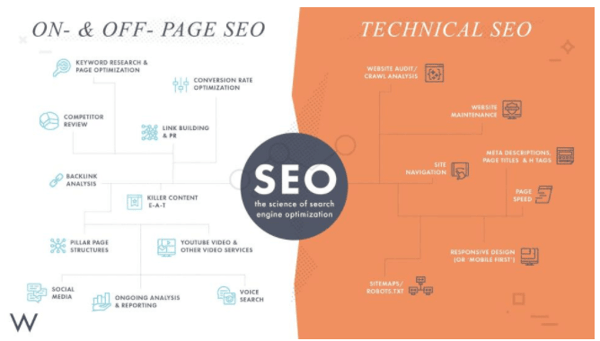SEO Checklist: 8 Must-Do Activities for Ongoing SEO Success
Written by
Believe it or not, search engine optimization (SEO) has been around for about two decades. Its humble beginnings in 1991 revolved around thwarting keyword stuffing, spammy backlinks, and other nefarious — not to mention barely regulated — website practices.
Since then, SEO has moved front-and-center into many an inbound marketer’s strategy to win prime real estate on page one of search engine results pages (SERPs). Given that 93% of online experiences begin with a search engine, and 75% of web users never scroll past the first page of search results, the importance of high rankings can’t be overstated.1
There are a number of SEO tools available to enhance website performance. However, analytics only get you so far. You need to be proactive in quarterly, monthly, and sometimes weekly SEO maintenance and management to yield the best results. Use this SEO checklist to make it happen:
- Page Speed Updates
- Backlink Monitoring and Management
- New Backlinks
- Position Tracking (Keyword Trend Monitoring)
- Index Errors
- Pillar Page Link Updates
- On-Page SEO: Page Optimization Updates
- Off-Page SEO
8 SEO Quick Wins
These SEO best practices are generally easy to implement and return impressive results:
1. Page Speed Updates
Page speed measures how fast page content loads, which in part drives the user experience. Not to be confused with site speed, which is the page speed for a sample of site page views, page speed refers to the time it takes for content to fully display on a page, or time to first byte — meaning how long it takes for browsers to receive the first byte of information from web servers.
Page speed should be evaluated (and updated, if needed) at least monthly.
2. Backlink Monitoring and Management
During link building, hyperlinks from websites other than your own are used in content. Sometimes, these links become corrupt and potentially harmful to your site. Backlink monitoring and management makes it possible to protect, review, analyze, and rid your site of any corrupt links. Further, performing a backlink gap analysis may reveal unlinked brand mentions and overlooked opportunities for solid link building.
Manual backlink monitoring and management should be done once every three months.
RELATED: HOW AND WHY CAN YOUR WEBSITE BENEFIT FROM A BACKLINK GAP ANALYSIS?
3. New Backlinks
Acquiring hyperlinks from websites other than your own is the backbone of link building. However, not all backlinks are suitable — or safe — for use.
To measure backlink quality, ask yourself these 4 questions:
- Does it come from a trusted, authoritative website?
- Does it include the target keyword in the anchor text?
- Does it come from a page topically related to yours?
- Does it come from a website that has not previously linked to yours?
Ideally, backlink building would be a constant, ongoing process weaved into other marketing tactics. However, a realistic expectation is to secure new backlinks once every three months.
4. Position Tracking (Keyword Trend Monitoring)
Position tracking (also known as rank tracking or SERP tracking) allows you to track website daily rankings based on a custom set of target keywords.
While the frequency of conducting the tracking largely depends on the targeted keyword lists, the way to successfully use position tracking is in comparing data. Previous actions taken during the same timeframe held up against new tracking results provide correlations and insights into up and down movement as well as strategic next steps.
As a general guideline, position tracking should occur on the keyword groups as follows:
- Critical keywords (top 10 keywords related to your business, industry, etc.) should be assessed on an ongoing basis using Semrush or other SEO tools
- Brand building keywords (related keywords with high search volumes) should be assessed quarterly
- Quick win keywords (easy “low-hanging fruit” keywords to leverage SEO) should be assessed quarterly
RELATED: THE ABC'S OF SEO KPIS: WHAT, HOW, AND HOW OFTEN
5. Index Errors
Index errors — also referred to as crawl errors — occur when Google’s bot/spider cannot properly index a site page. Index errors can occur for any number of reasons, making periodic SEO site health checks a smart and increasingly imperative strategy.
Outside of urgent error notifications, a site health review should be conducted semi-annually or quarterly, depending on the complexity of the website.
6. Pillar Page Link Updates
As additional content is developed for your site, linking it back to the corresponding pillar page is important for two main reasons: maintaining pillar page authority and avoiding Google index errors.
The status of all attached links from your pillar page should be checked monthly.
RELATED VIDEO: HOW TO USE PILLAR PAGES FOR POWERFUL LEAD ATTRACTION
7 & 8. On- and Off-Page SEO Audits
As far as checklists go, SEO can be parsed into the likes of an on-page SEO checklist, an SEO audit checklist, and a technical SEO checklist.
For the purposes of this discussion, we’ll focus on on-page and off-page SEO, but it’s important to note the interconnectedness and SERP ranking impact of all facets of SEO within an inbound strategy, as illustrated here:

7. On-Page SEO: Page Optimization Updates
On-page SEO optimizes individual web pages in order to rank higher and earn more relevant traffic in search engines. It’s important to note that unlike off-page SEO that focuses on backlinks and other external signals, on-page SEO is concerned with optimizing the content and HTML source code of individual pages.
On-page SEO page optimization updates for existing content should be revisited once every three months.
To learn more, read this: The Difference Between On-page and Off-page SEO
8. Off-Page SEO
Off-page SEO (also known as off-site SEO) refers to actions taken outside of your own website that affect its rankings within SERPs.
Off-page SEO should be revisited semi-annually.
While SEO is powerful, it should not be perceived as a stand-alone marketing tactic for increasing the quantity and quality of web traffic, SERP positioning, or leads. While it certainly influences outcomes, being intentional about how and when to use SEO best practices makes an inbound marketing strategy that much more comprehensive.
SOURCES
1Neil Patel, How to Show Up on the First Page of Google (Even if You're a Nobody), Undated
General:
HubSpot: Validate internal links between subtopic keyword content and pillar pages
Clariant Creative, Your Guide to Pillar Pages and Topic Clusters
Subscribe To Our Blog
Information. Insights. Ideas. Get notified every time a new Weidert Group blog article is published – subscribe now!
You May Also Like...

Search Engine Optimization
Optimize Your Industrial Website for AI Search

Marketing Technology
Why Unified Data Efforts Fail (and How Manufacturers Can Fix It)

Search Engine Optimization
How Falcon Rebuilt Industrial AI Search Visibility in 2025
Accelerate Your Growth with
Weidert Group
If you’re ready to explore a partnership, request a personalized consultation with our team.





